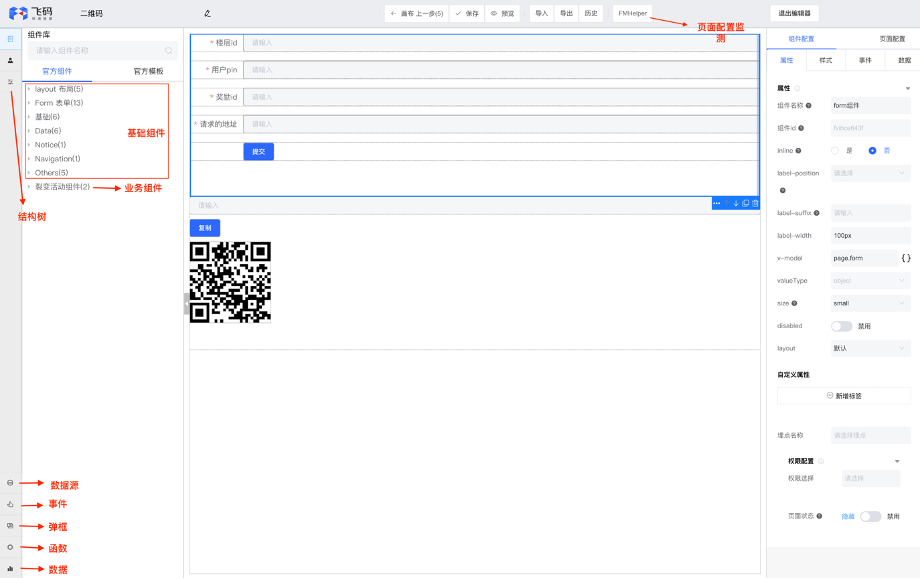在 ES6 的规范当中,ES6 支持元编程,核心是因为提供了对 Proxy 和 Reflect 对象的支持,简单来说这个 API 的作用就是可以实现对变量操作的函数化,也就是反射。
元数据
什么是元数据
元数据是指附加在对象、类、方法、属性、参数上的数据,它可以用来帮助实现某种业务功能需要用到的数据。
元数据的使用
Reflect-metadata- 是 ES7 的一个提案,它主要用来声明的时候添加和读取元数据,Typescript 在 1.5+ 的版本已经支持它,你只需要:
npm i reflect-metadata --save
紧接着你要在 tsconfig.json 文件中添加以下配置:
{
"compilerOptions": {
"emitDecoratorMetadata": true,
"experimentalDecorators": true
}
}
defineMetadata() 和 getMetadata()
该方法是一个函数重载,它既可以接收三个参数,也可以是四个参数,具体定义如下所示:
function defineMetadata(metadataKey: any, metadataValue: any, target: Object): void; function defineMetadata(metadataKey: any, metadataValue: any, target: Object, propertyKey: string | symbol): void;
它们的参数分别是:
-
metadataKey: 用于存储和检索元数据的键; -
metadataValue: 元数据的值; -
target: 要在其上定义元数据的目标对象; -
propertyKey: 目标对象上的属性;
有存值的就有取值的,这个方法也是一个函数重载,它的具体定义如下所示:
function getMetadata(metadataKey: any, target: Object, propertyKey: string | symbol): any; function getOwnMetadata(metadataKey: any, target: Object): any;
它的具体使用如下所示:
import "reflect-metadata";
const moment = { address: "广州" };
Reflect.defineMetadata("method", "hi,叼毛,你上班是不是在摸鱼", moment);
console.log(Reflect.getMetadata("method", moment)); // hi,叼毛,你上班是不是在摸鱼
Reflect.defineMetadata("method", "hi,靓仔,买菜吗", moment, moment.address);
console.log(Reflect.getMetadata("method", moment, moment.address)); // hi,靓仔,买菜吗
metadata()
Reflect.metadata(...) 方法的可以用于类或者类属性上,它的具体定义如下所示:
function metadata(
metadataKey: any,
metadataValue: any
): {
(target: Function): void;
(target: Object, propertyKey: string | symbol): void;
};
Reflect.metadata 当作 Decorator 使用,当修饰类时,在类上添加元数据,当修饰类属性时,在类原型的属性上添加元数据:
import "reflect-metadata";
@Reflect.metadata("inClass", "哇哈哈哈哈")
class Test {
@Reflect.metadata("inMethod", "我要喝喜之郎,我要当太空人")
public hello(): string {
return "hello world";
}
}
console.log(Reflect.getMetadata("inClass", Test)); // 哇哈哈哈哈
console.log(Reflect.getMetadata("inMethod", new Test(), "hello")); // 我要喝喜之郎,我要当太空人
在这里可能会有人就好奇了,这里面的方法怎么和上面的不一样啊,上面的是 defineMetadata(...),而这里直接用的 metadata(...),这是为什么呢?
答案是 defineMetadata(...) 它要确定你要是在哪里定义的元数据,而后者是直接以装饰器的方式调用,它已经明确知道了你就是给这个类来定义的元数据。
获取类型信息并赋值
我们可以通过 Reflect.getMetadata 方法来获取属性类型,并且对该属性进行赋值,如下操作所示:
import "reflect-metadata";
function Prop(): PropertyDecorator {
return (target, key: string) => {
const type = Reflect.getMetadata("design:type", target, key);
console.log(`${key} type: ${type.name}`);
target[key] = "moment";
};
}
class SomeClass {
@Prop()
public nickname!: string;
}
console.log(new SomeClass().nickname); // moment
例如在 vue-property-decorator 中通过使用 Reflect.getMetadata API,Prop Decorator 能获取属性类型传至 Vue,简要代码如下:
import { Vue, Component, PropSync } from 'vue-property-decorator'
@Component
export default class YourComponent extends Vue {
@PropSync('name', { type: String }) syncedName!: string
}
这样的写法就等同于以下代码所示:
export default {
props: {
name: {
type: String,
},
},
computed: {
syncedName: {
get() {
return this.name
},
set(value) {
this.$emit('update:name', value)
},
},
},
}
除了能获取属性类型以外,通过 Reflect.getMetadata("design:paramtypes", target, key) 和 Reflect.getMetadata("design:returntype", target, key) 可以分别获取函数参数类型和返回值类型,具体代码如下所示:
import "reflect-metadata";
function Func(): PropertyDecorator {
return (target, key: string) => {
console.log(Reflect.getMetadata("design:paramtypes", target, key)); // 函数参数类型
console.log(Reflect.getMetadata("design:returntype", target, key)); // 返回值类型
};
}
class SomeClass {
@Func()
moment(value: boolean): string {
return " ";
}
}
自定义 metadataKey
除了能获取类型信息外,常用与自定义 metadataKey,并在合适的实际获取它的值,具体实例代码如下所示:
import "reflect-metadata";
function classDecorator(): ClassDecorator {
return (target) => {
Reflect.defineMetadata("class", "类装饰器", target);
};
}
function methodDecorator(): MethodDecorator {
return (target, key, descriptor) => {
Reflect.defineMetadata("method", "方法装饰器", target, key);
};
}
@classDecorator()
class SomeClass {
@methodDecorator()
someMethod() {}
}
console.log(Reflect.getMetadata("class", SomeClass)); // 类装饰器
console.log(Reflect.getMetadata("method", new SomeClass(), "someMethod")); // 方法装饰器
参考文献
- 深入浅出 Typescript
总结
元数据的应用场景很多,其中 NestJs 就是使用了大量的元数组实现了控制反转和依赖注入,将会在下一篇文章中讲到,本篇文章到此结束。








